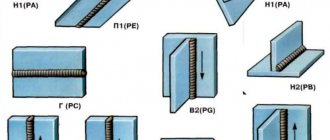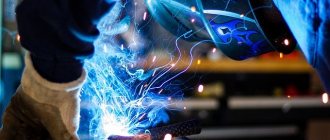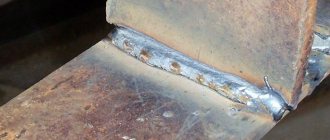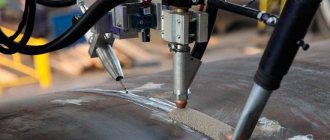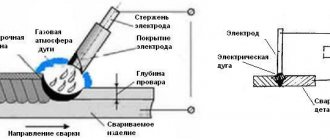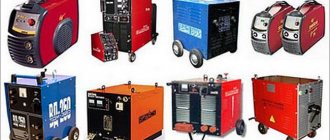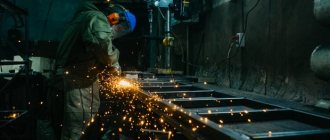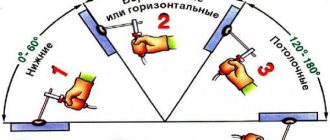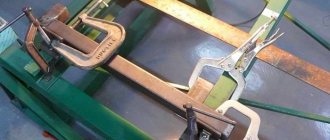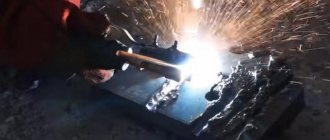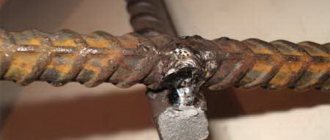Before welding, parts are placed in different spatial positions. One example is the fillet weld. The order of the process and the level of complexity of welding depend on its location relative to the horizon.
A corner connection is formed when parts are installed in the shape of the letter T, end-to-end or overlapping. It is found in most metal structures.
Fillet weld.
Fillet weld welding technology
When working with parts installed at an angle, use classic welding machines. You can use a simple transformer.
The disadvantage is the large size of the equipment. The best option is an inverter. Light weight and wide range of settings make it easier to work with complex seams.
When choosing a technology, take into account that:
- The current strength is set taking into account the diameter of the electrode and the thickness of the parts being connected. At a high value of the parameter, burns occur, at a low value, the rod sticks.
- A uniform, strong seam is obtained with oscillatory movements. Other methods of movement, such as zigzag, are acceptable.
- The ceiling seam is formed under conditions of rapid solidification of the melt. To do this, use a rod with a refractory coating, which is moved in a circular motion. This is not entirely convenient for the welder. As the electrode moves away, the arc weakens and the weld pool decreases. This results in a short circuit. This technology is complicated by overheating of the lower surfaces of the parts. Therefore, it is recommended to refuse it.
Rules for making welded ceiling joints
- The pre-welded sides are brought together as tightly as possible. If there are significant gaps, only a sufficiently experienced welder will be able to perform welding work efficiently.
- Next, the edges are cut, just as in the bottom position. If the metal thickness is more than 0.5 cm, then a V-shaped bevel is performed.
- It is recommended to bring the electrode to the ceiling plane at an angle of 45 degrees. Young, inexperienced welders are recommended to start welding with half of the electrode, so that during the work they can better control its tip, and this will make it easier to form the welded joint itself.
- The welding procedure can be performed in this spatial position due to the tension of the metal plane. In order to prevent drops of hot iron from flying off without having time to adhere to the edge, it is recommended to reduce the current strength.
- If the welded sides are brought together sufficiently tightly, the first seam can be made without oscillating movements of the electrode. This will make it possible to completely fill the joint with molten metal. The next pass needs to be made a little wider to strengthen the ligament. On pipes, of course, it is recommended to immediately make a wide seam.
- If there is a small gap between the metal plates being connected, an intermittent arc is used, which allows the deposited metal drop to cool. Instantly, without allowing the redness of the previous drop to go away, the next drop is applied.
Safety when welding a ceiling seam
When performing welding operations, it is imperative to focus on the safety precautions provided for events of this format. The final quality parameters of the seam and the personal safety of hired employees will depend on the implementation of simple recommendations.
When planning welding work, you need to pay attention to the following recommendations:
- All wires connected to welding equipment must be well insulated. The presence of bare sections of cables is not allowed, as this can lead to problems with the welding machine and increases the risk to the health and life of the user.
- The inverter must be disconnected from the network when not in use. It is possible that the equipment may turn on due to negligence. Also, following this rule will help protect the device from possible voltage surges in the electrical network.
- It is strictly forbidden to carry out welding work without personal protective equipment. The welder must wear a protective mask, protective clothing, shoes and gloves. Work must be carried out on a special mat.
- The fastening of ceiling joints should be carried out in a dry and warm room. It is not recommended to perform the task in rainy or snowy weather if there is a fairly high level of humidity in the room. Otherwise, this may negatively affect the quality of the ceiling seam. Only experienced craftsmen with the necessary knowledge can cope with the task in any conditions.
- Fire safety rules must be followed. This means that there should be no foreign objects or flammable materials near the welding site.
Types of fillet welds (welding positions)
Compounds are classified according to many criteria. First of all, this is a method of installing blanks. Depending on the requirements for the strength of the finished structure, the seam is made one- or two-sided.
In the second case, the seam is reliable and holds its shape longer. When welding on one side, the structure may become deformed.
Lower
When working in this way, one part is in a horizontal position, the other in a vertical position. The seam is formed at a right angle between the surfaces.
If the thickness of the workpiece does not exceed 12 mm, cutting the edge is not required, but the lower part of the sheet installed perpendicularly is cut so that the distance between the edges is less than 2 mm. When working with thick parts, a V-shaped cut is made.
Example of a fillet weld.
Vertical and horizontal
When welding parts located vertically, the melt flows down. Reducing the arc length helps eliminate the formation of droplets; to do this, the electrode tip is brought closer to the area being treated.
If the rod does not stick, it can be rested against the part.
Seam welding has the following features:
Vertical welding seam and electrode movement pattern.
- The metal is prepared taking into account the type of connection and the thickness of the workpieces. The parts are secured in the desired position and short tacks are applied. This prevents the structure from moving during operation.
- The seam is formed both from bottom to top and in the opposite direction. The first method is considered more convenient. Under the influence of the arc, the weld pool moves upward. The seam is of better quality.
- Fillet welding can be carried out in a vertical position with arc separation. During the break, the melt has time to cool. In this case, the same movements of the electrode are used as when welding without separation: in different directions, in a circle or in a loop.
- When welding from top to bottom, the rod is installed at a right angle to the surface of the workpiece. After the arc is excited, the part is heated, the tip is released and welding is carried out in this position. The method is not entirely convenient, since it requires constant monitoring. However, the seam acquires the required characteristics.
Horizontal connections can also be formed in different directions. The method is chosen taking into account the preferences of the welder. The bath also moves downwards, so the angle of the electrode is increased, taking into account the welding speed and amperage.
As the melt drains, they make faster movements and periodically tear off the arc. During these breaks, the metal cools down and no drops form. You can try changing the voltage. These methods are used in stages.
We recommend reading Existing types of welded joints
Horizontal weld seam.
Ceiling seams
This is the most difficult way to form compounds. It requires experience and constant monitoring of the treated area. During the welding process, the electrode is held perpendicular to the ceiling.
The arc length is minimal, the speed of movement is constant. The rod is moved in a circular motion, expanding the melting area.
Welding ceiling seams.
Into the boat
Corner joints often have to be welded on both sides. To carry out the process correctly, the workpieces are installed so that their planes are at the same angle. This method is called boat welding. This simplifies the selection of electrode movements and improves the quality of the seam.
Boat welding.
Equipment
Ceiling seams are welded using a conventional transformer or inverter. The difference between the inverter, which gives it an advantage, is the presence of a stabilizer, a low and high frequency rectifier, a control unit, a working shunt, and a current sensor. Using an electronic regulator, it is possible to regulate the current strength over a wide range. The presence of double insulation is protection against electric shock. The advantage is the compactness of the device and its light weight.
There are three types of welding inverters:
- Household . Used for metals with a thickness of no more than 3 mm.
- Semi-professional . Products with a thickness not exceeding 6 mm are welded. Has increased power. Requires short breaks to cool down.
- Professional . Can work without a break for 6-8 hours.
Electrodes are selected depending on the material being welded. Welding a ceiling seam with electrodes assumes their diameter is 3-4 mm. To reduce the amount of spatter, they should be well dried before welding.
Classification of seams
Connections are also classified according to the method of edge matching. They are T-shaped, overlapped, end-to-end or point.
We recommend that you read
Existing types of welded joints
Lap joint
This method is used when working with thin sheet metal. The seam is boiled on both sides so that moisture does not penetrate into it and rust does not appear.
When laying parts overlapping, choose the inclination of the electrode correctly, which should be from 15 to 45 degrees. This helps to get a strong, reliable seam.
When deflected upward or downward, the bulk of the melt is displaced. The strength of the connection decreases or a weld seam does not form at all.
Overlap welding.
With edges joining to one point
This method is used when working with sheet metal or pipe ends. The blanks are installed at a distance of 1-2 mm from each other and secured with clamps.
When welding, the gap is filled with melting wire. Thin sheets are welded without additional preparation (cleaning from rust is always mandatory).
When working with thick parts, make a double or single seam, the edges are cut in the following ways:
- The edges of workpieces 4-12 mm thick are processed using any method. One-sided cutting is considered convenient. Thick parts are cut in the shape of the letter V. U-shaped cutting is a more complex method, used less frequently. If there are increased requirements for the quality of the seam and a thickness of more than 8 mm, the edges are cleaned on both sides.
- When welding parts larger than 12 mm, a double connection is required. Such a layer of metal cannot be heated evenly on one side. The edges are cut off on both sides, forming something like the letter X. It is not advisable to use V- or U-shaped methods: a larger volume of melt will be required to fill the gaps. Electrode consumption increases, operating speed decreases.
If thick parts will be joined with one-sided cutting, the melt is applied in several approaches. Such seams are called multilayer.
T-joint
This method involves installation in the shape of the letter T. The connection is formed on both one and both sides.
Edge cutting is performed depending on the thickness of the parts:
- for values up to 4 mm, no treatment is required;
- if the thickness is 4-8 mm, make a double seam without cutting;
- a metal layer of 4-12 mm requires the formation of a single seam with one-sided cutting;
- When working with parts thicker than 12 mm, double-sided processing is required.
The fillet weld is considered a type of T-weld. When forming it, the same recommendations are followed: thin sheets are boiled without edge treatment. For greater thickness, remove part of one or both sides.
T-joint welding seams.
With or without edge cutting
Proper welding of corner joints requires careful preparation of the edges of the elements. Joints of thin parts do not require additional measures.
Welded seams with edge preparation.
When welding without cutting, traces of corrosion are removed by brushing the metal until it shines. The edges of products of medium thickness are beveled at an angle of 45° on the attachment plate.
The backing is necessary to retain the additive and increase the strength of the seam. When cutting on both sides, the edge cone is truncated. This protects the edges from sagging and burns.
Precautionary measures
For ceiling seams, you should wear a thick jacket and trousers. Gloves must cover the cuffs, otherwise scale will reach the elbows and burn the skin. A hat or cap without a visor is required on the head. It is important to choose trousers of such length that they cover the collar of the shoe to prevent molten particles from getting inside.
Since the spray hits the ground and spreads further, there should be no flammable objects nearby. You need to use safety glasses to beat off the slag, because it will fall down on the welder. Frequent rest will allow you to relieve stress from the muscles of your neck and arms and get the job done efficiently.
Welding in the ceiling position is not mastered immediately. It takes practice and patience. It’s good to take a few minutes a day and weld two pieces of pipe or corner to the table and try to weld them from below. Having mastered this method, you can safely weld pipes and metal structures of any complexity.
Common problems
Novice welders often make mistakes that contribute to the occurrence of defects. Some significantly worsen the quality of the seam, others only affect aesthetic characteristics.
It is necessary to detect defects in a timely manner and eliminate them. The most common problems are uneven filling or differences in seam width. As you gain experience working with fillet welds, errors occur less frequently.
Lack of penetration at the connection point
The defect occurs when the joint is partially filled with melt. This requires timely correction, since the strength of the weld decreases.
We recommend reading Features of an overlap welding joint
The main reasons for lack of penetration are:
- low current setting;
- moving the electrode too quickly;
- improper cutting of edges of thick parts.
To eliminate lack of penetration, increase the power of the arc and reduce its length. If the parameters are selected correctly, the defect will not reoccur.
Example of lack of penetration of a connection point.
Uneven impact
This error is manifested by the formation of pores or sagging. The former are voids located linearly or chaotically, the latter are protruding areas of the melt. Both phenomena are unacceptable because they negatively affect the performance of the finished structure.
The appearance of pores is promoted by:
- improper protection of the weld pool, excessive consumption of inert gas;
- use of low-quality electrodes;
- exposure of the welding zone to wind, which deflects the gas cloud (oxygen in this case reacts with the melt);
- presence of traces of corrosion or dirt on parts;
- improper edge processing.
Sagging occurs when working with filler material due to incorrect selection of welding mode and parameters. These elements are not connected to the main part. It is recommended to remove them mechanically.
Pruning the area
The defect is a depression along the seam. Occurs with increased arc length. The weld pool expands, the temperature is not enough to warm up the edges of the workpieces. The metal immediately hardens, forming undercuts.
To eliminate the defect, reduce the arc length or increase the current.
During fillet welding, an undercut can also occur due to improper holding of the electrode. The melt flows down, causing a groove to appear. In this case, the power of the arc is reduced and shortened.
Welding seam defect.
Seam burn
The defect is a through hole.
Its appearance is facilitated by:
- too much current;
- slow guidance of the rod;
- increased distance between the edges of the part.
To eliminate the defect, select the correct operating parameters of the device and reapply the suture.
Cold and hot cracks
The second type of defects appears during the cooling stage of the metal. They are directed across or along the seam. Cold cracks occur on an already hardened seam when the structure experiences excessive loads.
Such defects lead to gradual destruction of the connection. To eliminate the defects, the seam must be re-formed. If there are a large number of cracks, the edges of the parts are cut off.
Cold cracks during welding.
Incorrect calculations
When choosing incorrect parameters for the operation of the device, different types of defects arise. The seam loses strength and becomes deformed.
The main causes of problems are considered to be:
- Incorrect leg. The quality of the welded joint depends on the correct choice of voltage and the speed of the electrode. The latter must be kept at the same level. If the current is insufficient, the rod operates at low speed, and the base metal does not melt well. At a high value of the parameter, the leg becomes concave and burns are formed.
- Oblique angle. It is quite difficult to install the parts in the desired position. The design loses the required qualities if the tilt of the attachment plate shifts to one of the sides.
Electrode selection (table)
The diameter of the rod is selected taking into account the thickness of the workpieces being welded. The choice is also influenced by the position of the workpieces, the leg of the seam, the type of connection, and the method of cutting the edges.
The table will help you install the correct electrode.
| Workpiece thickness, mm | 1-2 | 3-5 | 4-10 | 12-24 | 30-60 |
| Rod diameter | 2-3 | 3-4 | 4-5 | 5-6 | 6-8 |
The values are approximate as they depend on many factors. For example, when working with ceiling seams, you should not use elements with a diameter of more than 4 mm. Such rods are not used for multi-pass welding either. This contributes to uneven welding of the edges.
Secrets of work
Welding a ceiling seam with electrodes is carried out using some “techniques” that simplify the process and improve the quality of the finished result:
- It is better to work with a short arc, this increases accuracy;
- It is better to hold the electrodes with a slight deviation to the side, this reduces the likelihood of spreading of the deposited metal;
- the width of the seam should not be greater than the diameter of the electrode used;
- the seam is made “towards oneself”. This approach makes it possible to control its quality and condition, as well as choose the most comfortable working pace.
The most optimal technology
The best method for welding corner joints is the “boat” method. This technology allows the arc to reach the root. In this case, you need to properly secure the workpieces. The angle between the welded edges must be straight.
Welding begins from the bottom, gradually moving the weld pool upward. Before cooking, you need to study the movement pattern of the rod. When parts are less than 1.4 cm thick, it is not necessary to bevel the edges. The edges of thicker pieces are cut off.
It is not always possible to install parts for boat welding correctly. When using a different technology, pay attention to the leg of the seam. When its length is up to 8 mm, a single-layer connection is made.
For larger sizes, the seam must be multi-pass. At the first stage, the root is boiled using a thin electrode. After this, the following passes are performed.
General recommendations
Ceiling weld
During welding, the molten metal is held from falling by surface tension. That is why it is necessary to reduce the size of the weld pool as much as possible. To do this, you need to periodically move the electrode to the side so that the metal has time to harden slightly.
In addition, the width of the rollers is reduced. As a rule, it is 2-3 electrode widths. Typically, electrodes with a diameter of no more than 4 mm are used for the welding seam . When the archwire is removed, undercuts sometimes form. Hold the electrode on the edges to avoid this.
The electrode must be dry, otherwise the gases released may enter the weld, reducing its quality. When welding using this technique, the evaporation of slag and gases from the molten metal is reduced. Therefore, welding seams in the ceiling have lower metal properties than when welding in other positions .
It is recommended to carry out welding on the ceiling yourself; this will allow you to clearly observe the process and select the speed and method of welding. Materials with a thickness above 8 mm are welded in several passes. The root seam is usually performed with a 3 mm electrode, and subsequent ones - with 4 mm.
It is important to know! Before welding, the ends to be joined must be processed and chamfered in accordance with GOST 10948-64. After each roller, the slag layer should be carefully removed. Welding tolerances for connections are described in GOST 5264-80.
About the specifics of the process in general
Before starting welding, you need to prepare the joints. They should form a right angle. One part is placed horizontally, the other – vertically.
We recommend reading How quality control of welded joints is carried out
The edges of T-shaped structures require mandatory cutting. However, this step is skipped when working with lap seams. The connection is formed in the corners formed when metal sheets are placed on top of each other.
The classic fillet weld consists of two structural elements connected to each other. In this case, cutting off the end of one of them is required.
Cutting edges for butt joints.
We cook pipelines, special requirements
Only experienced, certified and highly qualified craftsmen are allowed to work with industrial pipelines.
Pipe connections belong to the vertical method with all the “vertical” nuances. The peculiarity lies in the angle at which the electrode is held, this is an angle of 45 degrees. The width of the pipe seam can reach 4 cm, it depends on the thickness of the pipe itself. There are separate standards for this type of welding, for example, GOST 16037-80 describes the dimensions of seams for various connections of pipeline structures.
Welding instructions
Welding of T-joints is carried out as follows:
- Prepare the equipment. Using special tables, current and voltage are set.
- Install the electrode. In one plane, the rod should tilt in the direction of its movement.
- Excites an electric arc. When using the argon-arc method, gas supply begins.
- Make small potholders. After they cool, the formation of a continuous connection begins.
- Start finishing the seam.
Cleaning welds
After completion of work, particles of metal, slag and scale remain on the surfaces. The seam protrudes slightly above the surface, which impairs the aesthetic qualities of the structure. Such defects are eliminated by stripping. The procedure is performed in stages. First of all, remove slag or scale with a hammer and chisel.
At the next stage, if necessary, level the treated area. In this case, use a grinder with a metal grinding attachment.
The abrasive grain size is selected taking into account the required surface smoothness. When welding soft metals, the weld is tinned: covered with tin solder.
Cleaning welds with burrs.
Content
- The essence of the submerged arc welding process
- Welding patterns
- Features of submerged arc welding
- The role of flux in welding
- Submerged arc welding methods
- Laser welding technology
- Types of welds produced by submerged arc welding
- Submerged arc welding modes and techniques
- Butt welding
- Welding T-, fillet and overlap welds
- Welding of structural carbon steels
- Welding low alloy steels
- Welding of medium alloy steels
- Welding of high alloy steels
Important Features
When using some fillet welding methods, you need to take into account nuances that can complicate the work.
Working with a ceiling seam
Welding of such joints proceeds normally only when the metal quickly solidifies after melting. A similar requirement applies to the formation of vertical seams.
To speed up the cooling process of the metal, electrodes coated with a refractory composition are used. Circular movements are combined with straight movements. The ceiling method should be used only if welding in other positions is impossible.
Even with a slight distance of the rod from the treated area, the arc goes out because there is not enough energy to maintain it. Because of this, the metal cools down, the weld pool narrows, which contributes to a short circuit.
Bottom heating of the treated area can complicate the work. Particles of molten metal fall deep into the weld, reducing its strength.
Direction of electrode guidance in a gas environment
When using a protective substance, the method of moving the rod plays an important role. There are left and right options.
The difference between the directions lies in the following features:
- When moving the rod to the right, the visibility of the weld pool improves, which makes the penetration deeper and the arc more stable. In addition, the method minimizes the amount of splashes generated.
- When left-handed, the melt sprays out more often. The penetration is shallow. The visual overview of the treated area is not impaired. The left direction of the electrode helps clean the weld pool. This method is more effective when welding aluminum alloy workpieces.
Restricted areas
When installing pipelines, the welder is faced with working in hard-to-reach places. To solve the problem, special measures have been developed.
This applies to polypropylene products often used in everyday life. When installing new plastic elements, situations arise in which the installation conditions differ from normal ones.
In this case, special tools are used:
- welding soldering iron;
- a set of nozzles (the best option is Teflon products);
- pipe cutter included in the welding soldering iron kit;
- degreaser;
- a set of fittings and other auxiliary elements.
By melting with a soldering iron, it is possible to form any type of corner joint. Special nozzles are used to combine elements of different diameters.
Transmission welding
This method implies the absence of direct contact. In this case, welding begins with careful preparation of the place where the parts are combined.
The method can only be used for working with thick-walled pipes of medium diameter. This means cutting a chamfer at an angle of 65-70°. To fix the parts, a centralizer is used to prevent the workpieces from moving.
The gap in the lumen should be 2.5 mm. Taking this parameter into account, the diameter of the rod is selected. An electric arc apparatus, for example an inverter, is used for welding.
What are the difficulties of welding a ceiling seam?
Few welders would call laying ceiling joints their favorite pastime, since many difficulties arise during the work process. It will not be easy for a beginner to learn, and many, after the first failures, simply lose all interest in this kind of activity. In order to master the basics of such a difficult science, you need to work on prevention. That is, understand the problems that will arise when laying the seam and try to prevent them.
Welding a ceiling seam with an inverter or transformer installation is very different from ordinary horizontal welding. When the workpieces are joined on the work table, a weld pool is formed along the joint. The welder can only control the melt process, avoid basic mistakes and prevent slag from getting into the bath. When all this has to be done on the ceiling, the molten metal tends downwards and it is very difficult to form a bath.
In addition, the slag, being in a molten state, drips and interferes with guiding the electrode along the joint. The splashes hit the surface below, scatter into many particles and create additional difficulties in work. But the main difficulty lies in connecting the workpieces to be welded. Most often, a weld pool can be formed only on one of the edges, while the second remains “out of use” and it is not possible to tie them together for a long time.
